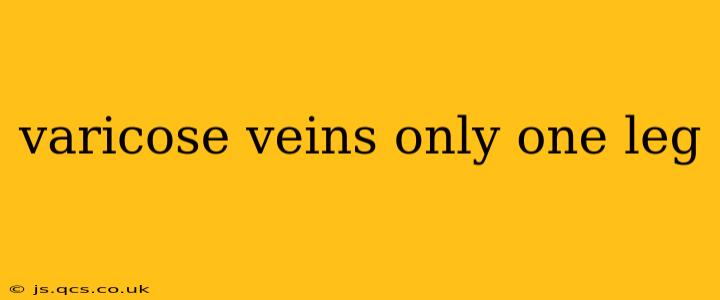Varicose veins, those unsightly, bulging veins often appearing blue or purple, are a common condition affecting millions. While they can appear on both legs, it's not uncommon for them to develop in just one leg. This raises questions about the underlying causes and the best treatment options. This comprehensive guide will delve into the reasons why varicose veins might affect only one leg, exploring the various contributing factors and available treatments.
Why Do Varicose Veins Appear in Only One Leg?
The development of varicose veins is often attributed to weakened or damaged valves within the veins. These valves usually prevent blood from flowing backward, but when they malfunction, blood pools and causes the veins to enlarge and become visible. While the exact reason for this occurring in just one leg can vary, several factors play a significant role:
-
Leg dominance: Most people favor one leg over the other, leading to increased pressure and strain on the veins in that leg. This is particularly true for individuals who stand or walk for extended periods. The dominant leg bears more weight, increasing venous pressure and potentially leading to the development of varicose veins.
-
Previous injury or surgery: Any trauma or surgical procedure affecting the leg's veins can disrupt blood flow and increase the risk of varicose veins. Even a seemingly minor injury could potentially compromise vein valves, impacting the circulation system over time and causing varicose veins to develop.
-
Deep vein thrombosis (DVT): A blood clot in a deep vein, known as DVT, can increase the risk of varicose veins. While DVT can affect either leg, if it occurs in one leg, it's more likely that varicose veins will also manifest primarily or initially in the same leg due to changes in blood flow and venous pressure.
-
Underlying medical conditions: Certain conditions like obesity, pregnancy, and prolonged sitting or standing can increase the pressure on the leg veins. If these conditions predominantly affect one leg, it's more probable for varicose veins to appear there. Furthermore, some individuals might have a genetic predisposition to weaker venous valves, potentially increasing the risk if there are other contributing factors.
Can Varicose Veins in One Leg Spread to the Other?
While varicose veins primarily affect one leg initially, there's a possibility of them developing in the other leg over time. This is because the underlying issues—such as weakened valves or increased venous pressure—might not be confined to a single leg. If the contributing factors are systemic, such as obesity or a genetic predisposition, the other leg could become affected later.
What Are the Symptoms of Varicose Veins in One Leg?
The symptoms of varicose veins in one leg are typically similar to those experienced when they affect both legs. These symptoms include:
- Visible bulging veins: These are often blue, purple, or dark red in color and can be twisted or rope-like.
- Leg pain and aching: This pain is often worse after prolonged standing or sitting.
- Leg swelling: This is a common symptom, especially towards the end of the day.
- Leg cramps: These can be particularly painful, especially at night.
- Skin changes: The skin over varicose veins can become discolored, itchy, or dry.
What Are the Treatment Options for Varicose Veins in One Leg?
Treatment options for varicose veins in one leg are the same as those used when both legs are affected. The best approach depends on the severity of the condition and individual factors. Common treatments include:
- Compression stockings: These help improve blood flow and reduce swelling.
- Lifestyle changes: Maintaining a healthy weight, regular exercise, and avoiding prolonged standing or sitting.
- Sclerotherapy: Injection of a solution into the affected veins to close them off.
- Endovenous laser ablation (EVLA): Using laser energy to close the affected veins.
- Radiofrequency ablation (RFA): Using radiofrequency energy to close the affected veins.
- Surgical removal (phlebectomy): Surgical removal of varicose veins.
How Can I Prevent Varicose Veins?
While genetics play a role, certain lifestyle choices can significantly reduce the risk of developing varicose veins, especially if they're prone to impacting only one leg:
- Maintain a healthy weight: Excess weight increases pressure on leg veins.
- Exercise regularly: Regular physical activity improves circulation.
- Elevate your legs: Elevating your legs when sitting or resting can help reduce leg swelling.
- Wear compression stockings: Compression stockings can help improve circulation and prevent blood pooling.
- Avoid prolonged standing or sitting: Take frequent breaks to move around and improve circulation.
This information is for general knowledge and does not constitute medical advice. Always consult a healthcare professional for diagnosis and treatment of varicose veins or any health concern. Early detection and appropriate treatment can help prevent complications and improve your quality of life.
